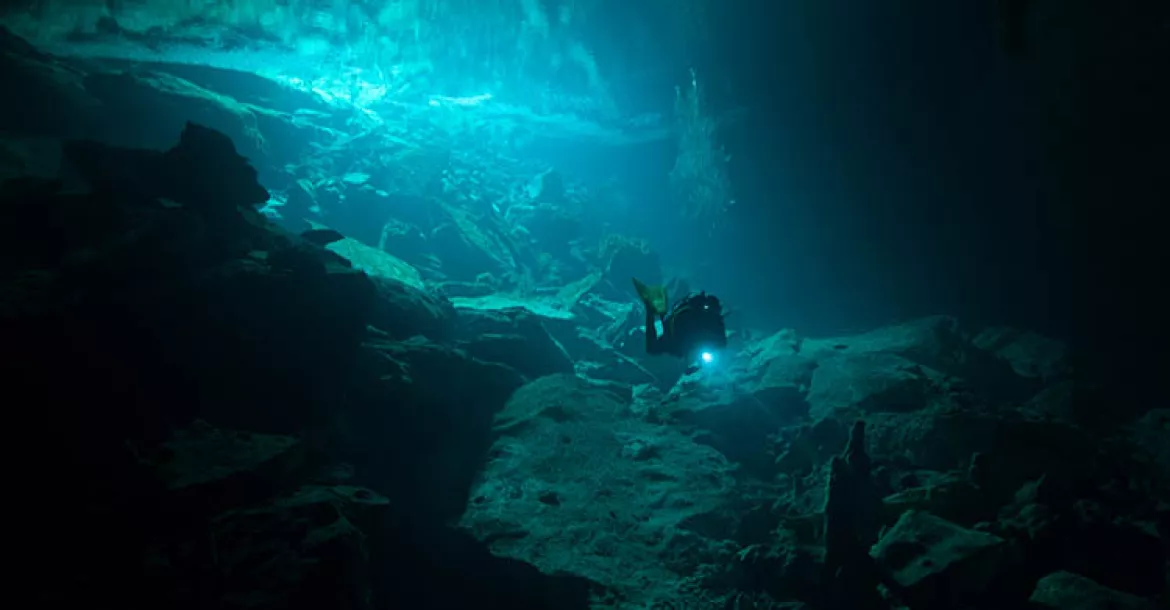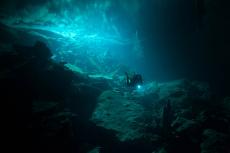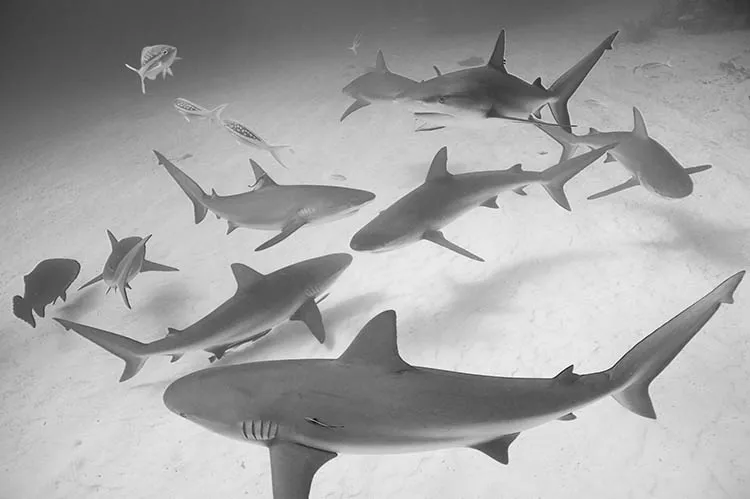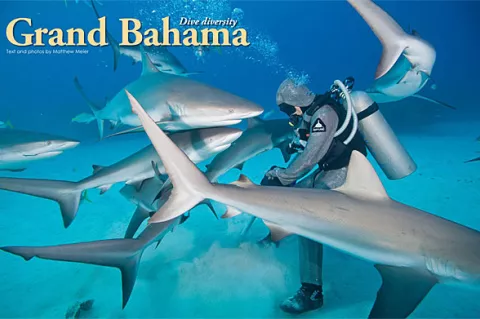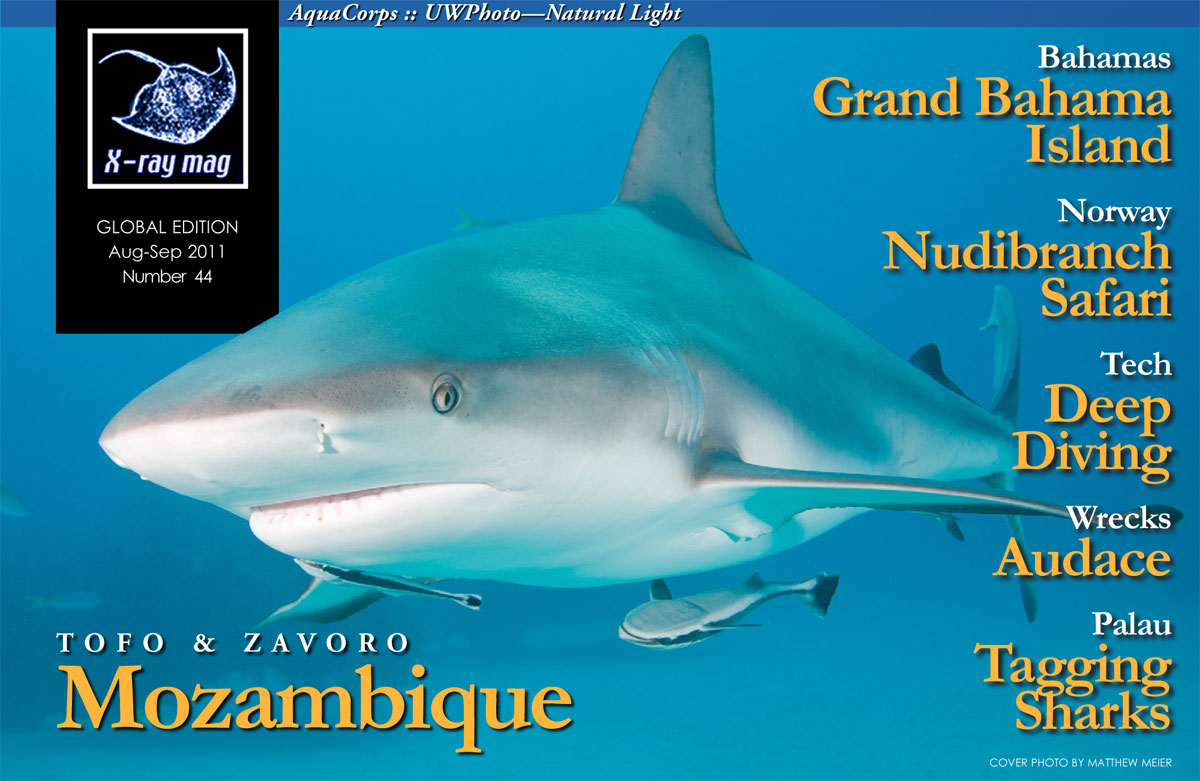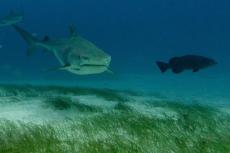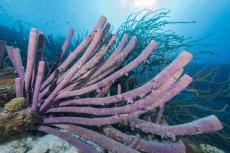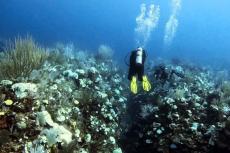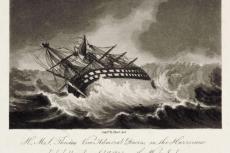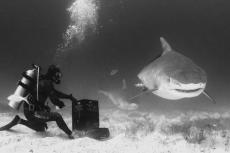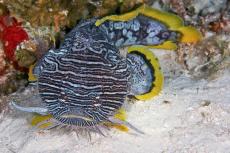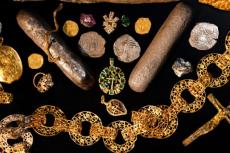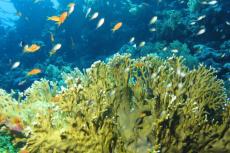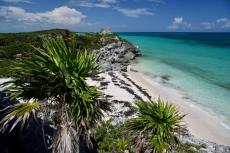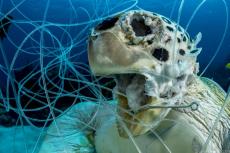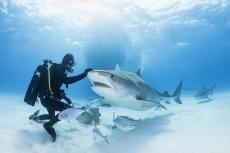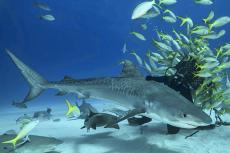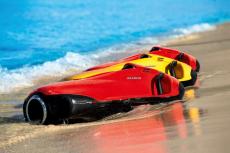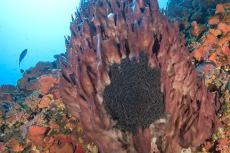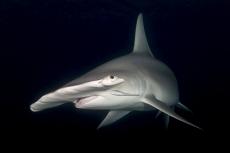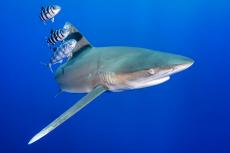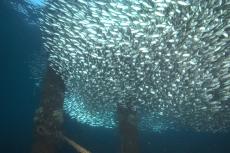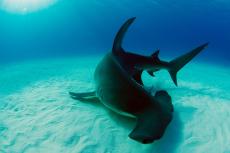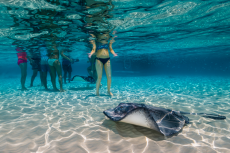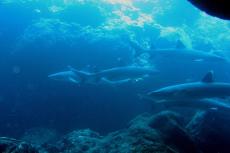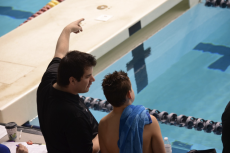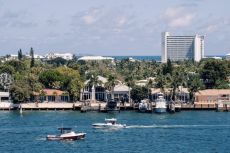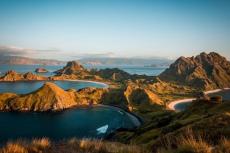Have you always wanted to dive with sharks? Hug a dolphin? Explore shipwrecks, caves and colorful coral reefs? What if you wanted to have all of these adventures wrapped into one destination? Then, it is time to visit the Caribbean island of Grand Bahama.
Contributed by
Factfile
Matthew Meier is a professional underwater photographer and travel writer based in San Diego, California.
To see more of his work and to order photo prints, please visit: matthewmeierphoto.com.
Located 55 miles due east of Florida and roughly 100 miles from Ft. Lauderdale or Miami’s International Airports, Grand Bahama is easily accessible from the U.S. mainland by plane, boat or cruise ship. It is the fifth largest of the approximately 700 islands in the Bahamas island chain while enjoying a modest population of only 75,000 people. The Bahamas capital city of Nassua alone has 250,000.
The relaxed atmosphere of Grand Bahama is apparent as soon as you set foot on the island. Simply looking down upon the turquoise waters during the flight in is enough to kick start your attitude adjustment. Those crystal clear waters are legendary for their astonishing visibility, so it is no wonder they have played host to several Hollywood movies including Pirates of the Caribbean, Splash, Cocoon and the James Bond movies Thunderball and Never Say Never Again.
Dolphins
Grand Bahama is the only place in the world where you can interact and swim with captive dolphins in the open ocean. The Dolphin Experience is run by UNEXSO (Underwater Explorers Society), and they are responsible for a breeding program of 16 Atlantic bottlenose dolphins. These second and third generation captive dolphins live in a natural nine-acre lagoon called Sanctuary Bay.
There are several different dolphin encounters to choose from, with varying levels of involvement. The dolphin interactions range from standing on a submerged platform, to swimming with dolphins in the lagoon, to open ocean snorkeling and scuba diving with dolphins along the coral reef and ultimately to becoming a trainer for the day. At every level, the dolphins perform behaviors on your command, interact up close and personal and even pose for photos while you give them a hug or a kiss.
I was fortunate enough to be able to participate in both the open ocean snorkel and the scuba diving encounters with the dolphins. On both occasions, two dolphins escorted us from Sanctuary Bay, following their trainer’s boat through the canals to the open ocean.
Along the way, the dolphins were asked to perform jumps and spins beside the boat, and at their trainers command, they exploded out of the water in perfect unison, soaring high in the air, before splashing back into the ocean. Prior to each encounter, the dolphin trainer gave a briefing explaining the plan for the day and an overview of hand signals with which to elicit behaviors from the dolphins. Once at our destination, the trainer expertly managed the dolphins as they were sent to one diver or snorkeler at time to perform behaviors at our request. We were able to swim alongside the dolphins, have them spin us in the water, give them a hug and go for a ride while holding onto their dorsal fins.
I have spent a lot of time in the water with dolphins and have to admit that I never tire of the experience. There is something truly remarkable about interacting with these amazingly intelligent and playful creatures.
Shipwrecks
There are numerous shipwrecks to be explored in the waters around Grand Bahama. Some were sunk as the result of storms or ran aground on the coral, and others were sunk intentionally as artificial reefs.
The largest vessel we explored was called Theo’s Wreck. Sitting on her port side in 100 feet of water, the adventurous may penetrate Theo’s hull both at the cargo hold and the engine room. Formerly a 228-foot cement hauler, she was sunk intentionally by UNEXSO in 1982. Working your way down the mooring line, Theo’s Wreck is an impressive site as she materializes from the depths. The wreck has a myriad of coral and sponge growth on her hull and a resident green moray eel can usually be found. Given her size and depth, it takes several dives to explore the full structure properly. Sadly, we were only able to dive Theo’s Wreck once during our stay, and I look forward to seeing more of her on my next trip.
La Rose is a classic triple-decker tugboat that sits upright in 95 feet of water next to a dive site called Moray Manor. Sunk in 2004 as an artificial reef, the wreck’s close proximity to the sloping coral reef allows for longer bottom times by using a tiered dive profile. We were able to spend 10-15 minutes on the wreck at 80-90 feet and then work our way up into the large coral heads that populate Moray Manor, all the while being escorted by a large, inquisitive barracuda. Once on the reef, we were entertained by a school of bar jacks congregating above a huge colony of great star corals.
Another popular site we dove was Papa Doc’s Wreck. Though truth be told, the only thing left of the original 1968 shipwreck were the engine blocks. Sunk in a storm, the original boat carried a group of mercenaries headed to fight in the Haitian revolution to overthrow François “Papa Doc” Duvalier. Now in its place, sitting 50 feet deep and upright in the sand, is a tugboat named the Badger. The wreck supports a healthy array of reef fish safely tucked away in the wheelhouse and significant coral and sponge growth is starting to show on its hull. If you look closely out in the sand you may even find a kitchen sink nearby. In my case, a Caribbean reef shark and some trailing bar jacks were kind enough to swim between the sink and the tug making for a fun photo.
The last of the shipwrecks we visited during out stay was called the Pretender Wreck. Other than the base of the hull and twin props sticking up a few feet out of the sand, there was little left to see. In fact, I would bet that most folks who dive this site never even notice the wreck at all. That is primarily because this spot is also called Shark Junction, and divers are usually kneeling in the sand along the edge of the Pretender, surrounded by circling Caribbean reef sharks.
Sharks
The shark feeding dive on Grand Bahama is not to be missed. There are a couple of outfits that offer this dive, but I would recommend UNEXSO, who pioneered shark feeding on Grand Bahama over 20 years ago. Diving supervisor, Cristina Zenato, has been feeding sharks here since 1995 and was recently inducted into the Women Diving Hall of Fame for her efforts in ocean and shark conservation.
I have never experienced a more peaceful, fascinating and exhilarating dive in my life. A dozen or more Caribbean reef sharks swam slow circles around the feeder and in and around the divers, waiting for their opportunity to be fed. This was not a feeding frenzy where sharks fought one another for food in a cloud of stirred up sand.
This was a chance to see these wondrous creatures up close in a carefully controlled encounter, making for an amazing underwater adventure. Never did I feel threatened or that the sharks were looking at me as food. I had countless sharks pass within inches of me without a hint of aggression. The sharks knew exactly where their food was located, and we humans were simply not on their menu.
During the dive, divers line up shoulder to shoulder, kneeling on the sand in 40 feet of water. Once everyone is in position, the shark feeder approaches, dressed in a chain mail suit and followed by a procession of eager sharks. The feeder then methodically extracts one fish at a time from an enclosed container and hand feeds an individual shark as it passes by.
If guests are lucky, they will also get to witness a shark being put into a state of tonic immobility. This is a natural paralysis in animals that is often induced by turning an animal onto its back, or in the case of some sharks, by placing one’s hands on its snout. The shark becomes rigid, and its breathing becomes steady and relaxed. While in a state of tonic immobility, the feeder is often able to bring the shark over to the guests so that they might touch a shark in the wild. UNEXSO also offers a shark feeder course if you would like to learn to hand feed sharks yourself.
Before and after the shark feeding dive, the crew educates guests on the need to conserve sharks, dispels myths surrounding sharks, describes specifics of shark behavior and explains the dangers sharks currently face from humans.
Scientific studies estimate that humans kill between 26 and 73 million sharks each year, and you will often see that number quoted as high as 100 million sharks. Most of these sharks have their fins cut off while still alive and are then thrown back into the water to drown. The fins are valued for shark fin soup and command a high price on the black market.
Caverns and caves
Grand Bahama has the second largest underwater cave system in the world, with over 32,000 feet of mapped tunnels. The vast majority of those tunnels require specialized cave training, a certified guide and permits. For divers like myself that are not cave certified, there are also a few large caverns at the mouth of these caves in which we were able to dive.
The largest cavern is at the entrance to Ben’s Cave, on the eastern side of the island, within the Lucayan National Park. The cave is named after Ben Rose who first dove here in 1967. Ben still lives and works on Grand Bahama and is one of only two people certified to train new guides. (Cristina Zenato is the other.)
Accessed by way of a spiral staircase to a long wooden deck below, the cavern is roughly 200 feet long, 100 feet wide and 50 feet deep.
As you descend into the water, the first 25-30 feet consists of crystal clear freshwater. Beneath the freshwater sits a halocline, which is a salinity gradient within a body of water (Wikipedia). Less dense freshwater from the landforms a layer over saltwater, which connects through the cave system to the ocean.
Passing through the halocline stirs up the salt and fresh water and reduces visibility, so it is imperative to mind your depth. Within the cavern, there are large rock boulders that are likely the result of the roof collapse that exposed the opening to the cave. There are also huge stalactite and stalagmite formations created over the millennia before the cave was flooded.
Bats nest in the roof of Ben’s Cave from the first week of May through the first week of September. In the past, the cave was closed during this time but is now open to the public year-round. The cave system connects underground to another opening within the National Park called Burial Mound Cave. Several Lucayan Indian remains were found, perfectly preserved, under a mound of rocks, in a water-filled cavern near this entrance.
Owl’s Hole Cave is another spot with a fairly large cavern at its entrance.
This limestone sinkhole is approximately 50 feet in diameter and requires a harrowing 30-foot descent down a vertical steel ladder before hitting the water’s surface. Named for the owls that nest on the interior ledges, this entrance to the cave system connects to another, called Mermaid’s Lair, by way of roughly 3,000 feet of underground tunnels.
Reef
The coral reefs surrounding Grand Bahama Island are colorful, varied and full of life. They play host to large star coral formations, flexible sea rods and vibrant sponges in every color. West Indies spiny lobsters hide under ledges, as do the occasional spotted and green moray eels. Reef fish abound from jacks to groupers, porkfish to squirrel-fish, parrotfish, surgeonfish, filefish, goatfish, grunts and chubs. Garden eels and jawfish can be found in the sand if you are patient and slow on approach.
Unfortunately, the common lionfish, an invasive species in the Caribbean, can also be found here. Native to the Indo-Pacific, they have no natural predators, a voracious appetite and are breeding exponentially. Some of the local dive guides have taken to spearfishing them to help cull their numbers on the reef. I am told that if prepared properly, they are quite delicious to eat as well.
The dive sites around the island are categorized by their depth and degree of difficulty. There are deep-water tongue-and-groove coral formations where you can expect to see sharks, turtles and other pelagic species. Medium depth reef formations, from 40-60 feet, typically consist of scattered coral bommies growing up out of the sandy bottom. Shallow reefs rise from 20 feet nearly to the surface and are perfect for beginner divers.
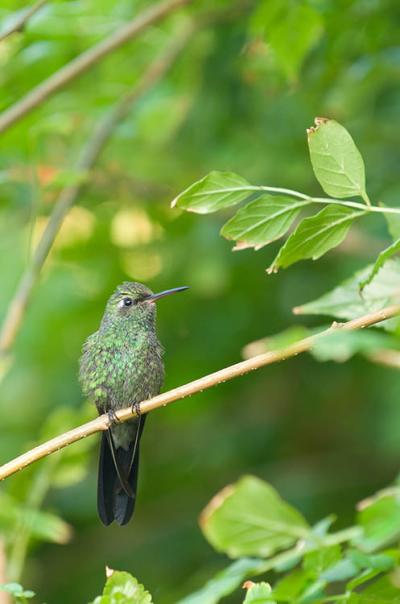
Topside
Grand Bahama offers a nearly endless array of non-diving activities to keep you entertained. Sporting pursuits include fishing, golf, tennis, bike riding, sailing, kayaking, horseback riding, windsurfing, parasailing and water skiing. There are casinos, shops, fantastic restaurants, live music and dancing at your fingertips. If that all sounds too hectic, perhaps you would enjoy a quiet stroll along an empty, white sand beach or simply sitting by the pool to soak in the sun.
A must see during your visit is the weekly, Wednesday night, Smith Point Fish Fry. Locals and tourists alike gather at family run restaurants right on the beach to enjoy delicious local fare, dancing and music. Whole fried fish and fried chicken are served with peas ‘n’ rice, mac ‘n’ cheese, potato salad, coleslaw, conch salad and conch fritters. Slug down a Gulley Washer or a Rum Punch afterwards and you have had a night to remember.
A Jeep tour is a great way to see the island of Grand Bahama. Guests drive their own vehicles and follow a guide, caravan style, as they explore some of the beautiful beaches on the south side of the island and learn a bit of history as the guide narrates along the way. Continuing east the tour pass over the Grand Lucayan Waterway on the Casuarina Bridge. At 58 feet tall, the bridge is the second highest point on Grand Bahama and is the only way to get across to the east side of the island.
The Grand Lucayan Waterway is an 8.5 mile long canal that cuts the island in half and allows small boat traffic easy access from north to south and back again. Construction on the waterway started in 1955, and the bridge was erected ten years later. As the tour proceeds towards the north side of the island, red mangroves and shallow wetlands replace sandy beaches. This area is famous for its bone fishing and is vital as a nursery to many young fish species, in addition to providing protection to the island from storm surge.
Pit stops along the way include the Garden of the Groves, a 12-acre botanical garden featuring lush vegetation, waterfalls and indigenous and migratory birds and wildlife. While strolling through the garden, savor a bite to eat or browse the Garden Shoppes to experience authentic Bahamian arts, crafts and products.
Named after Wallace Groves and his wife Georgette, who founded the city of Freeport, the newly renovated garden re-opened in 2008 after sustaining significant damage from two different hurricanes in 2004. The island is nearly covered in Caribbean pine tree forests and they were the original draw for Groves, who settled here to start a lumber company.
Another stop might include the Lucayan National Park and Gold Rock Beach. Here you can examine Ben’s Cave on foot, take a kayak tour through the mangroves along Gold Rock Creek or enjoy a quiet lunch on the white sand beach.
If you are interested in a more private and customized tour experience, I would suggest one of the local guides. Several are available, but after repeated local recommendations, I spent a lovely afternoon with Ms. Paddy Wildgoose. She escorted us on a cultural tour towards the West End of the island, highlighting several of the local communities along the way. Ms Paddy is a wealth of information and a pleasure to be around. Originally from Nassau, she has been on Grand Bahama for over 45 years.
I look forward to visiting Grand Bahama again soon. There simply was not enough time for all the things I wanted to do on one trip. Numerous dive sites were missed, several wrecks still need to be explored and countless topside adventures have yet to be experienced. Perhaps I will even muster up the courage to hand feed the sharks. Come join me in Grand Bahama for your next dive trip or family vacation. You will thank me if you do. ■
Matthew Meier is an underwater photographer and dive writer based in San Diego, California. To see more of his work and to order prints, please visit: www.matthewmeierphoto.com
A very special thanks to Cristina Zenato and UNEXSO (www.unexso.com) for providing diving services on this trip; Pelican Bay Hotel (www.pelicanbayhotel.com) for their superb lodging; and the Bahamas Ministry of Tourism (www.bahamas.com) for providing airfare and coordinating land tours.
Thanks to Ed Gates and Grand Bahama Nature Tours (Grandbahama naturetours.com) for our Jeep tour. And finally thanks to Ms. Paddy Wildgoose at Red Carpet Taxi (paddytaxitour@gmail.com) for the cultural tour and airport shuttles.
Special thanks to Cressi-sub for providing gear used in the production of this article.
Visit: www.cressi.it

